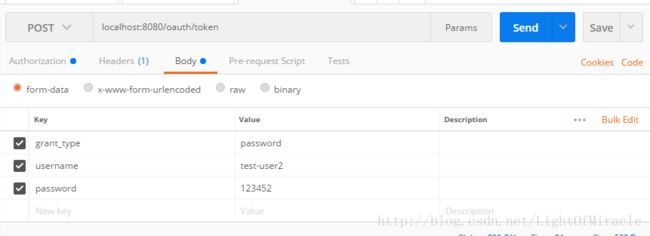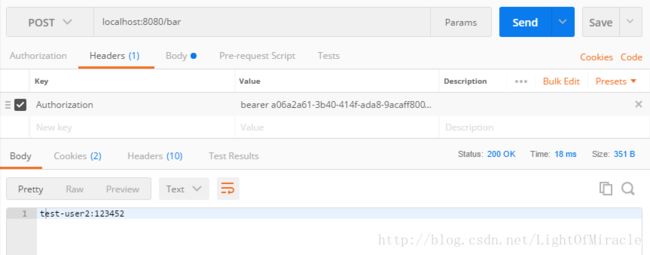Spring Boot整合oauth2.0搭建统一授权服务(密码模式)
前言
写这个博客得原因是最近想要将自己得api单独发布给第三方使用,但是又不想被别人滥用,所以想弄一个授权服务,但是网上关于oauth2.0的资料层出不穷,看了之后完全不明白应该如果实际的去整合,现在基本成功后记录下来。
关于oauth2.0的概念以及相关的知识等可以建议参阅理解OAuth 2.0。
准备
新建一个Spring Boot的web项目并导入一下依赖:
org.springframework.security.oauth
spring-security-oauth2
org.springframework.boot
spring-boot-starter-security
org.springframework.boot
spring-boot-starter-web
配置
配置EnableAuthorizationServer
@Configuration
@EnableAuthorizationServer
public class OAuth2AuthorizationConfig extends AuthorizationServerConfigurerAdapter {
@Autowired
private AuthenticationManager authenticationManager;
@Autowired
private UserDetailsService userService;
@Autowired
private TokenStore tokenStore;
@Override
public void configure(ClientDetailsServiceConfigurer clients) throws Exception {
clients.inMemory()
.withClient("test")//客户端ID
.authorizedGrantTypes("password", "refresh_token")//设置验证方式
.scopes("read", "write")
.secret("123456")
.accessTokenValiditySeconds(10000) //token过期时间
.refreshTokenValiditySeconds(10000); //refresh过期时间
}
@Override
public void configure(AuthorizationServerEndpointsConfigurer endpoints) throws Exception {
endpoints.tokenStore(tokenStore)
.authenticationManager(authenticationManager)
.userDetailsService(userService); //配置userService 这样每次认证的时候会去检验用户是否锁定,有效等
}
@Bean
public TokenStore tokenStore() {
//使用内存的tokenStore
return new InMemoryTokenStore();
}
}UserService接口定义如下:
public interface UserService extends UserDetailsService {
//后期在此新增UserService的业务接口
}其中UserDetailsService只包含一个需要实现的方法,具体实现:
@Primary
@Service("userService")
public class UserServiceImpl implements UserService {
private final static Set users = new HashSet<>();
static {
users.add(new User(1, "test-user1", "123451"));
users.add(new User(2, "test-user2", "123452"));
users.add(new User(3, "test-user3", "123453"));
users.add(new User(4, "test-user4", "123454"));
}
@Override
public UserDetails loadUserByUsername(String s) throws UsernameNotFoundException {
Optional user = users.stream()
.filter((u) -> u.getUserName().equals(s))
.findFirst();
if (!user.isPresent())
throw new UsernameNotFoundException("there's no user founded!");
else
return UserDetailConverter.convert(user.get());
}
private static class UserDetailConverter {
static UserDetails convert(User user) {
return new MyUserDetails(user);
}
}
} 根据方法名很容易明白spring 的组件会调用此方法去获取到用户的信息并去验证。
这里的用户信息直接写死的,实际中可以用jdbc或者其他配置等方式。
同时loadUserByUsername方法要求返回一个UserDetails接口:
public interface UserDetails extends Serializable {
Collection getAuthorities();
String getPassword();
String getUsername();
boolean isAccountNonExpired();
boolean isAccountNonLocked();
boolean isCredentialsNonExpired();
boolean isEnabled();
}并且spring已经有了它的一个实现:org.springframework.security.core.userdetails.User类
由于User这个名字很容易和我们项目中的实体User重名这里选择继承这个类自己实现一个UserDetails:
/**
* 自定义UserDetails类 携带User实例
*/
public class MyUserDetails extends User {
private com.example.oauth.pojo.User user;
public MyUserDetails(com.example.oauth.pojo.User user) {
super(user.getUserName(), user.getPassword(), true, true, true, true, Collections.EMPTY_SET);
this.user = user;
}
public com.example.oauth.pojo.User getUser() {
return user;
}
public void setUser(com.example.oauth.pojo.User user) {
this.user = user;
}
}到此基本的配置就已经完成了,
测试
写一个测试的Controller:
@RestController
public class UserController {
@Autowired
private TokenStore tokenStore;
@PostMapping("/bar")
public String bar(@RequestHeader("Authorization") String auth) {
MyUserDetails userDetails = (MyUserDetails) tokenStore.readAuthentication(auth.split(" ")[1]).getPrincipal();
User user = userDetails.getUser();
return user.getUserName() + ":" + user.getPassword();
}
}启动项目:
访问:localhost:8080/bar
返回未授权
访问:localhost:8080/oauth/token获取token
这里的Authrization字段中Basic后面是配置中的clientId + ":" + secret的Base64编码结果
我这里是:test:123456的Base64编码结果
返回token信息:
使用token访问controller:
成功。
github源码戳这里~





